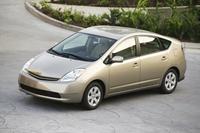Hybrid Review: 2005 Toyota Prius
WISHING FOR BUMPER-TO-BUMPER TRAFFIC
By Marc J. Rauch
Exec. Vice President & Co-Publisher
There was a time when I hated driving in heavy traffic, such as the years I spent commuting from Queens to Manhattan. The 13-mile trip from Flushing to W.48th Street, by way of the BQE and Midtown Tunnel, would take between one-and-a-half to two-hours, each way. This meant that my average speed was 6.5 to 9 miles-per-hour, slower than you'd drive through a parking lot.
Thankfully, I only did that for five years!
I'm not saying that I would have enjoyed the commute better if I was driving a Toyota Prius, but if I did, I sure would have gotten great fuel mileage. From what I can tell, there are only two quirky things about the Prius (although neither is quirky-bad, just quirky). The first is its exterior shape, the second is that it gets better gas economy in slow stop-and-go driving (as compared to traditional, non-hybrid vehicles that get better fuel usage at highway speeds than in city conditions). During the week that I test-drove the Prius I found myself looking for ways to maximize its fuel efficiency. I drove routes that I normally don't take, drove during times that I typically don't, and drove slower than I usually do. It’s like I was trying to make up for all the bad fuel economy years I spent in New York and later in Southern California.
Alas, Sacramento is not New York or LA, so to properly test out the car’s fuel economy I purposely took a morning rush-hour ride into San Francisco. Only one word can describe my trans-Bay Bridge/Golden Gate experience: Wahoo! I averaged 57 miles-per-gallon, very close to the advertised top range.
By now, everyone should know that the Prius is a hybrid gas/electric vehicle, so I won't waste a lot of time introducing this feature or explaining how it works or fawning over. Suffice to say that the Prius' early incarnation as a small inconvenient road experiment gave way in 2004 to a surprising road-worthy vehicle that can seat more than two people comfortably, while carrying a reasonable amount of cargo/luggage, and performing comparably well to virtually any mid-priced 4-door vehicle. In owning a Prius, you'll give up nothing to other gas-only vehicles in its class.
Ergonomically speaking, I have a couple of items to point out. I love the keyless entry and push button start, which is not unique to the Prius, and the simple transmission shifter. The animated graphic representation of how the power plant is performing (accessed on the center console LCD screen) is fascinating to watch and play with. However, I dislike the horizontally split rear-window, although I presume that an actual owner would get accustomed to it in short order. I also find the climate control to be a bit cumbersome. While temperature control and AC on/off is mounted on the steering wheel, there are no such controls for fan speed or air output direction. You have to reach over to the LCD screen (a long reach for someone like me with short arms), access the climate interface and then make the selection). If the LCD screen is on another interface (audio, navigation, or energy/fuel consumption info), then this is not the simple one-step process commonly found in most vehicles.
The Prius has become a familiar part of the motoring scene, at least here in California. The shame is that there aren't more of them on the road and that there’s such a long waiting list to get one. One of the best things about the Prius is that it’s a Toyota product. This means it feels good, drives smoothly and safely, sports a nicely designed interior, and can be expected to be mechanically reliable. The downside is that the price for a fully equipped version is now over $26,000: six thousand over the base MSRP price and about $2,000 more than last year’s full-boat version. On the other hand, if industry scuttlebutt is correct, and the Prius is being “subsidized” by Toyota (some say it should really retail in the $35k area) in order to establish an alternative/hybrid foothold, then the $26k price tag makes it the best buy on the market. Perhaps this is part of the reason why there’s such a long buyer’s waiting list. The Prius makes for a great general family car, and an ideal middle manager/salesmen’s car.



